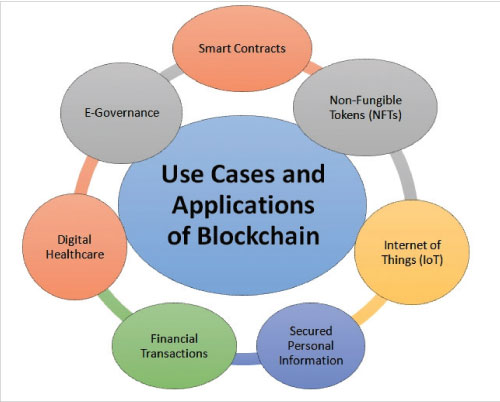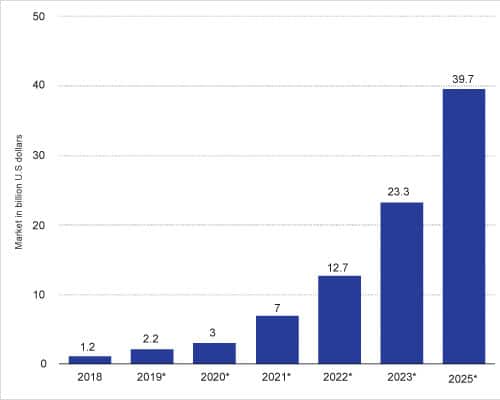Blockchain Development Platforms and Toolkits: A Quick Look
Blockchain is currently used in a variety of applications and fields, including e-governance, logistics and financial transactions. There are quite a few platforms and toolkits available today that can be used to develop a blockchain.
According to a report by GrandViewResearch.com, there is a huge scope for blockchain-based implementations. Between 2022 and 2030, the blockchain technology market is projected to increase at a compound annual growth rate (CAGR) of 85.9 percent, from a market size of $5.92 billion in 2021. Increased venture capital investment for blockchain technology startups is one of the reasons for this market expansion. For example, blockchain technology provider Circle Internet Financial Ltd disclosed in May 2021 that it had secured $440 million in investment from institutional and strategic investors. Legalization of cryptocurrencies in nations such as El Salvador and Ukraine is expected to open up new avenues for blockchain expansion.
The main applications and use cases for blockchain are:
- Cryptocurrencies and financial transactions
- Supply chain management
- Non-fungible tokens (NFTs)
- Digital health records
- Smart contracts
- E-governance
- Secured personal information
- Gaming
- Digital voting
- Internet of Things (IoT)

The blockchain market is segmented into digital identity, exchanges, remittances, smart contracts, logistics management, and others based on applications. Blockchain technology increases the efficiency of payment systems, lowers operating costs and makes transactions transparent. Due to the advantages it offers, its application in payment solutions is growing. Blockchain eliminates the need for a facilitator in the processing of payments, which is another important reason for its growth.
According to data from Statista.com, the blockchain technology market size has grown quite rapidly in recent years and is expected to reach close to $40 billion by 2025.
The acceptance of cryptocurrencies in some countries is encouraging companies and investors to increase their investments in blockchain technology. Decentralized finance (DeFi) is a new blockchain-based financial system that reduces the power banks have over financial services and payments. Blockchain technology market growth is believed to be driven by strategic efforts in the decentralized finance domain.
Table 1: Frameworks, platforms and toolkits for blockchain development
| Platform and software toolkits | How it can be used in blockchain development |
| Truffle suite URL: |
Useful for smart contract development and blockchain emulation |
| Solidity URL: |
Multipurpose programming language for smart contracts |
| Vyper URL: |
Secure and contract-oriented programming language |
| Rust URL: |
Efficient and reliable blockchain development software |
| Hard hat URL: |
Extensible, fast and flexible environment for blockchain development |
| Post on URL: |
Powerful framework for decentralized app development |
| ThirdWeb URL: |
Framework for Web3 development in the blockchain environment |
| Geth URL: |
Implementation patterns and modules for Ethereum |
Blockchain vs traditional applications
Blockchain improves the traceability, security, reliability and transparency of data shared across a business network, while saving costs. The traditional web-based applications are centralized, which can be exploited or hacked by malicious traffic.
Blockchain for businesses uses an open, immutable digital ledger that only authorized blockchain members can see. The nodes in the network control what data each organization or member can see and what actions they can take. Because business partners do not need to trust each other, blockchain is often referred to as a “trustless” network.

This trust is based on the increased security, transparency and immediate traceability of blockchain technology. Beyond issues of trust, blockchain offers commercial benefits such as cost savings due to accelerated speed, efficiency and automation of transactions.
Blockchain technology has the potential to fundamentally change how sensitive and important data is viewed. It reduces fraud and illegal behavior by generating a record that cannot be changed and is encrypted end-to-end. By using permissions to restrict access and anonymize personal data, privacy concerns are addressed. To prevent hackers from accessing data, information is held across a network of computers rather than on a single server.
Without blockchain, each company must maintain a different database. Blockchain uses a distributed ledger, which ensures that transactions and data are recorded consistently across all locations. Full transparency is offered since any network user with permissions can see the same data at the same time. All transactions are time- and date-stamped records with immutability. Thanks to this, members can access their entire transaction history, which virtually eliminates the possibility of fraud.
Blockchain establishes an audit trail that records the asset’s origin at each stage of its journey. This helps industries plagued by fraud and counterfeiting. Blockchain makes it possible to directly communicate provenance information to customers. Traceability data can reveal weak points in any supply chain, such as items stored on a loading dock while being transported.
Traditional paper-intensive processes take a long time, are subject to human error, and often require third-party mediation. Transactions can be completed faster and more efficiently by automating these operations with blockchain. The blockchain can contain both documentation and transaction information, eliminating the need for paper exchange. Settling and settling takes place faster because there is no need to reconcile several ledgers.
With smart contracts, transactions can be automated, which increases productivity and further accelerates processes. The next stage in a transaction or workflow is automatically started after pre-specified requirements are met. Smart contracts reduce the need for human involvement and are less dependent on external parties to verify that a contract’s provisions have been adhered to. For example, when a consumer submits an insurance claim, it can be immediately settled and paid once he or she has provided all the necessary evidence.
Platforms and toolkits for blockchain development
A variety of frameworks and programming platforms are available for developing and deploying blockchain-based applications. Table 1 shows some of the important ones.
Blockchain technology has a large variety of development frameworks and platforms for use in many applications. Many of these platforms are open source and free, and can be used to design and develop algorithms in a variety of fields, such as security, authentication, privacy, and cryptocurrency.


